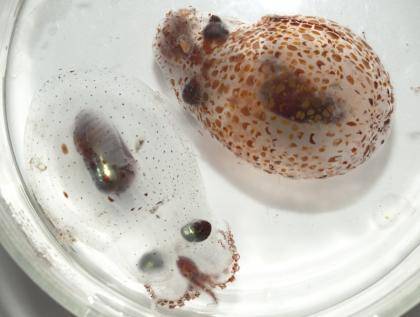
If you're a snack-sized squid or octopus living in the ocean zone where the last bit of daylight gives way, having some control over your reflection could be a matter of life and death.
Most predators cruising 600 to 1,000 meters below the surface spot the silhouette of their prey against the light background above them. But others use searchlights mounted on their heads.
Being transparent and a little bit reflective is a good defense against the silhouette-spotters, but it would be deadly against the "headlight fish," says Duke postdoctoral researcher Sarah Zylinski.
Transparency is the default state of both Japetella heathi, a bulbous, short-armed, 3-inch octopus, and Onychoteuthis banksii, a 5-inch squid found at these depths. Viewed from below against the light background, these animals are as invisible as they can be. Their eyes and guts, which are impossible to make clear, are instead reflective. But when hit with a flash of bluish light like that produced by headlight fish, they turn on skin pigments, called chromatophores, to become red in the blink of an eye.
During ship-board experiments over the Peru-Chile trench in 2010, Zylinski shined blue-filtered LED light on specimens of both creatures to watch them rapidly go from clear to opaque. When the light was removed, they immediately reverted to transparent. On a second research cruise in 2011 in the Sea of Cortez, Zylinski measured the reflectivity of the octopuses and found they reflected twice as much light in their transparent state as in the opaque state.
Zylinski experimented with 15 to 20 different species of cephalopod pulled up from the deep by the research ships, but only these two responded to the blue light. "I went through several things I thought would stimulate behaviors," she says. Shallow-water cephalopods (squid, ocotopi and cuttlefish) will change their body patterns for a shadow or shape passing overhead, but these deeper water animals don't, Zylinski says. The animals could be seen tracking the movements of probes around them, but it was only the light that made them switch on the their pigments.
Zylinski next would like to investigate the link between transparency and habitat depth for the Japetella octopus. "Smaller young animals are found higher in the water column and have fewer chromatophores, so they are more reliant on transparency, which makes sense because there won't be predators using searchlights there," Zylinski says. But the mature adults have a higher density of chromatophores making them potentially more opaque and they can be found in deeper waters (below 800 meters) where bioluminescence becomes the dominant light source.
The work, which appears this month in the journal Current Biology, was funded by the U.S. Office of Naval Research and the National Science Foundation.
CITATION--"Mesopelagic Cephalopods Switch Between Transparency and Pigmentation to Optimize Camouflage in the Deep," Sarah Zylinski and Sonke Johnsen. Current Biology 21, Nov. 22, 2011. DOI: 10.1016/j.cub.2011.10.014